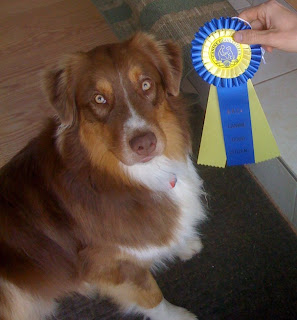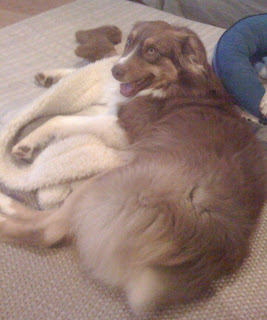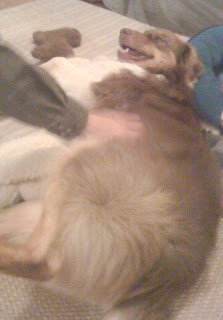
A Canine Good Citizen is a dog that passes a 10 part test called the AKC's Canine Good Citizen test. The purpose of the test is to show that a dog has good manners both at home and out in the community. The dog's handler must also promise they are responsible for their dog's health, safety, and quality of life. The dog must pass all 10 parts of the test to become a CGC dog and the test is given by an official CGC evaluator. Jenn is an evaluator, but she can't give me the test. It has to be done by another evaluator.
Both Big Sandy and Bernie are Canine Good Citizens, so I'd really like to be one too. Any dog, of any age can participate including mixed breed dogs like Bernie and dogs with disabilities like Big Sandy, who has three legs. CGC can be a first step towards Therapy Dog certification and other great activities.
Jenn's been working and practicing with me on the different tests and I've been taking the CGC class at the APS. The only test I don't like is the grooming. It is weird to have a person I don't know reach for my ears and feet and try to groom me. Jenn's helping me by feeding me treats so I associate positive things with being touched by strangers. But we can't use treats during the test!! Jenn can talk to me and praise me and gently pet me too.
From the AKC's website, the ten tests are:
Test 1: Accepting a friendly stranger
The evaluator walks up to the dog and handler and greets the handler in a friendly manner, ignoring the dog (in a sit/stay). The dog must show no sign of resentment or shyness, and must not break position or try to go to the evaluator.
Test 2: Sitting politely for petting
The evaluator pets the dog on the head and body. The dog may stand in place as it is petted. The dog must not show shyness or resentment.
Test 3: Appearance and grooming
The evaluator softly combs or brushes the dog, and in a natural manner, lightly examines the ears and gently picks up each front foot.
Test 4: Out for a walk (walking on a loose lead)
The dog's position should leave no doubt that the dog is attentive to the handler and is responding to the handler's movements and changes of direction. The evaluator may use a pre-plotted course or may direct the handler/dog team by issuing instructions or commands. In either case, there should be a right turn, left turn, and an about turn with at least one stop in between and another at the end.
Test 5: Walking through a crowd
The dog and handler walk around and pass close to several people (at least three). The dog may show some interest in the strangers but should continue to walk with the handler, without evidence of over-exuberance, shyness or resentment.
Test 6: Sit and down on command and Staying in place
The dog must do sit AND down on command, then the owner chooses the position for leaving the dog in the stay.
Test 7: Coming when called
The handler will walk 10 feet from the dog, turn to face the dog, and call the dog.
Test 8: Reaction to another dog
Two handlers and their dogs approach each other from a distance of about 20 feet, stop, shake hands and exchange pleasantries, and continue on for about 10 feet. The dogs should show no more than casual interest in each other. Neither dog should go to the other dog or its handler.
Test 9: Reaction to distraction
The evaluator will select and present two distractions. Examples of distractions include dropping a chair, rolling a crate dolly past the dog, having a jogger run in front of the dog, or dropping a crutch or cane. The dog may express natural interest and curiosity and/or may appear slightly startled but should not panic, try to run away, show aggressiveness, or bark.
Test 10: Supervised separation
The owner will go out of sight for three minutes. The dog does not have to stay in position but should not continually bark, whine, or pace unnecessarily, or show anything stronger than mild agitation or nervousness.
You can learn more about the Canine Good Citizen program by
clicking here.
 I went to the dog park today with Jenn and Bernie. Bernie likes to run around the park flushing birds and racing after squirrels. He's so fast. I love to follow him and chase after him when he runs.
I went to the dog park today with Jenn and Bernie. Bernie likes to run around the park flushing birds and racing after squirrels. He's so fast. I love to follow him and chase after him when he runs. Today, I tried to herd Bernie by nipping him on the shoulders as we ran. Well, wouldn't you know he growled at me and grabbed my face planting me into the ground! It was all quite unnecessary if you ask me. I got up and shook myself off and then Bernie licked his lips and looked away from me. Jenn ran over and made sure we were OK. She said we both did "calming signals" to diffuse the situation.
Today, I tried to herd Bernie by nipping him on the shoulders as we ran. Well, wouldn't you know he growled at me and grabbed my face planting me into the ground! It was all quite unnecessary if you ask me. I got up and shook myself off and then Bernie licked his lips and looked away from me. Jenn ran over and made sure we were OK. She said we both did "calming signals" to diffuse the situation. 






